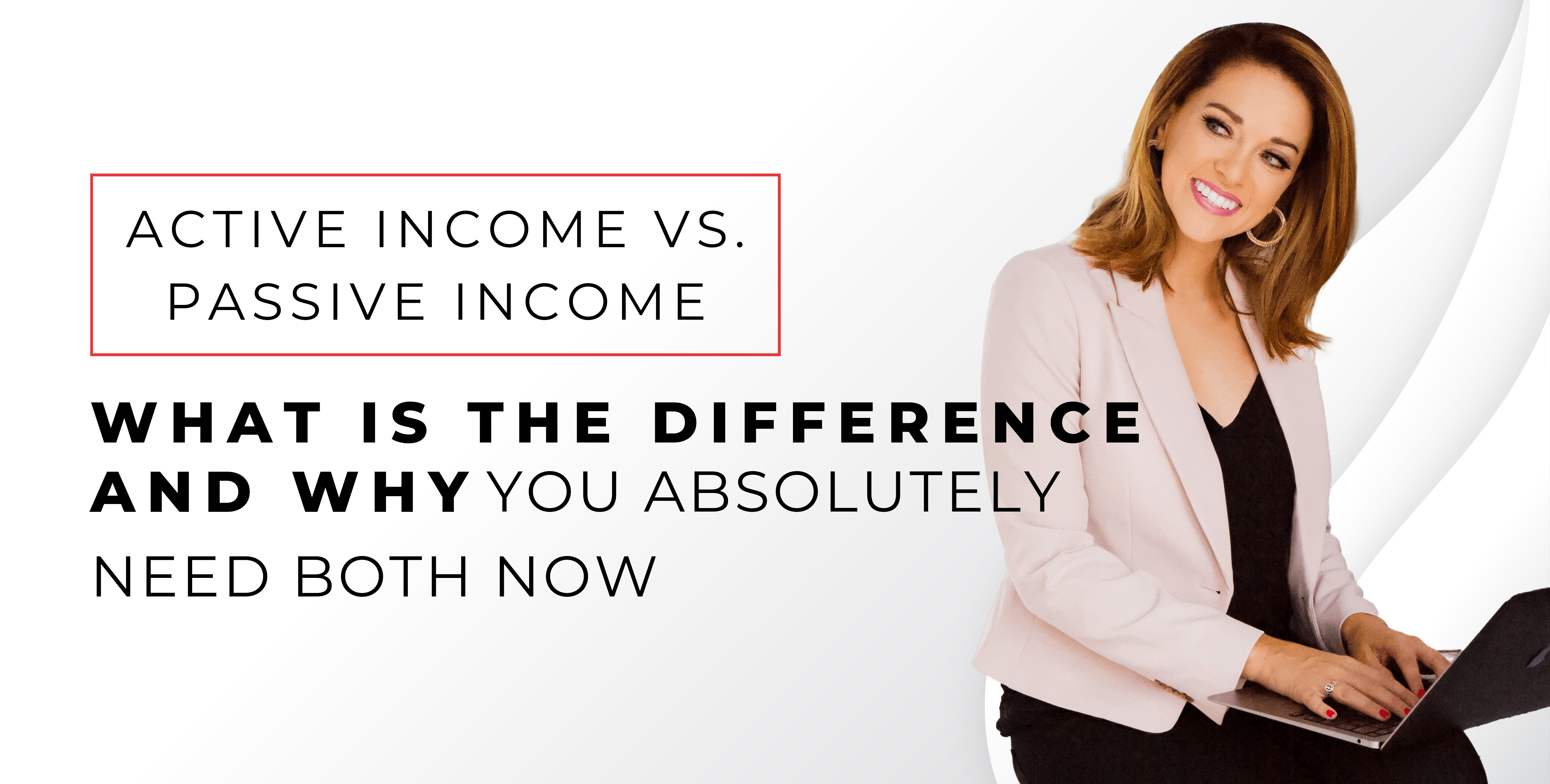If you want to be a millionaire, and build your empire, you need to understand the difference between active income vs passive income.
Table of Contents:
Why you need multiple streams of income
Active income for beginners
What is active income?
Passive income for beginners
What is passive income?
Opportunities for active and passive income as a business owner or service provider
Examples of active income streams for business owners
Examples of passive income streams for businessowners
Getting started with passive income
The average millionaire has 7 streams of income, and these streams of income are based on both active and passive places that they put their money. If you want to create multiple streams of income to reach the millions and beyond, you need to create more leverage by taking your current money and investing it. The idea is to get to the point that your money is making you more money (also known as “passive” income). In fact, even more money than you are making by showing up and actively doing the work (aka, your “active” income).
When you first begin to view money as a positive enhancement tool, you can learn how to duplicate and multiply it by exchanging value for money (whether that is working in your 9-5 job, freelancing, or servicing clients) and then reinvesting that money passively.
Let’s break down the differences between active income vs passive income, and why everyone should have multiple income streams if they want to build wealth over the long term – regardless of what career, business, or industry you are in.
Why is it Important to have multiple streams of income?
Having more than one income stream to rely on creates security, flexibility, and freedom in your life.
Even now, we see interest rates quickly creeping up. If you’re putting money in the bank, you want to make sure that you’re putting your money into the accounts with the highest yield which are bringing the highest return on investment. Passive income rests on principle: having your money in the right place in the right type of account that has the highest level of return.
Active Income for Beginners:
What is active income?
The definition of ‘Active Income’ is:
Income as a result of direct participation.
In other words, you need to show up and be involved in order to get paid. As a business growth strategist and mentor, I deliver coaching and consulting services to my clients in order to get paid – which is how I create active income. Active income can be your annual salary, wages, tips, commissions, etc.
The downside of relying solely on your active income is that If you are an employee and lose your full-time job, or are unable to perform the duties of your position, your income goes away. If you are a small business owner and can no longer deliver your services, you don’t get paid.
Active income is where everyone gets started; however, in order to create lifelong financial security, you need to start generating passive income as well.
Passive Income for Beginners
What is passive income?
The definition of ‘Passive Income’ is:
income generated with little effort required to maintain it.
In addition to coaching, I also sell online training programs, books, and online courses that I have already created that no longer require my involvement. Over time, the income generated from those revenue streams builds up and plays a larger role in our company’s annual revenue.
Using passive income to reach your financial goals
Imagine this: if you added $100 a month of passive income to your household income each month for the next 10 years, you would have generated $12,000 each year by the end of a 10-year period.
Regardless of the time and effort required to create passive income and get it up and running, it’s what allows you to meet and exceed your financial goals, retire comfortably, without having to worry about trading dollars for hours, or being on the clock 24/7.
Passive income is money you can earn even when you are not directly involved or present.
Common ways to start earning passive income:
Investing in real estate
Land flipping
Investing in a short term rental property
Stock trading
Any type of property income
Earnings from a business that do not require direct involvement from the business owner
Royalties from a book
Inside my Inevitable Millionaire mentorship program, I go over in-depth the different types of income streams every employee can tap into (even if you’re working a full time job, and looking to make extra money on the side) as well as dozens of income streams that you can build into your own small business.
If you’re a business owner looking to create passive income opportunities in your own company, let’s walk through some ways to earn money without a ton of extra legwork:
Opportunities for active and passive income as a business owner or service provider
The easiest way to build these new active and passive streams of income is through what I like to call a “lilypad effect”.
If you have your ear to the ground and are in close contact with your customers, it will be easy to identify new streams of income you need to create. So, ask yourself:
Where are your customers investing?
With whom are they investing and why?
When you pay attention to where your customers are investing their money, you can develop an internal stream of income and an opportunity for them to be able to make that investment with you. Don’t let them leave your ecosystem in order to solve that problem.
On the flip side, you need to take your active income and turn it into passive income by investing in other ventures. Ultimately, you want to get to the point where the things that you showed up and you actively worked on are producing a significant return.
This result allows you to replace (and even double or triple) your monthly income from the residual effect of tasks that you already did the work for, so you no longer have to show up and deliver constantly in order to achieve your financial goals.
Examples of active income streams for business owners
In our company, Kelly Roach Coaching, we have about 15 different streams of income – but it didn’t start that way. We started with one core stream of income: rapid business growth coaching to help business owners and CEOs accelerate their revenue. Now, we earn money through various channels in our business – coaching programs, products, online courses, mastermind programs, 1:1 consulting, and more. Below, I’m going to outline a few different ways you can earn active income in your business.
#1: Ascension Programs
An ascension model is a great way to increase revenue without adding new customers.
At one point, our company only offered 1:1 coaching for business owners, and eventually moved into small group coaching. As clients had success with the group coaching to build and grow their business, however, the next problem that they were facing was learning how to build a team and how to implement systems.
From there, we created our ascension program, Legacy Builders, to help clients build infrastructure and build a winning team. Though, as they had success in that program, the next problem that arose was learning how to build a leadership team and understand leadership principles that would allow them to multiply, duplicate and scale. In turn, we created our Legacy Leaders Mastermind to help CEOs go from seven to eight figures and build self-led companies.
If you want to create ascension opportunities for your current customers, ask yourself this:
Once my clients have success in my initial program, what problems does that create at the next level? And, how can I solve those problems?
Types of Ascension Programs You Can Create:
-
Mastermind model. A mastermind is less focused on strategy and tactics, and more on elevated conversations. They are loose, collaborative, and based on strategic networking and partnerships versus content. They can include:
- Virtual or in person retreats
- Quarterly meetups
- Series of collaborative group calls
- High-end 1:1 mentorship
- Tier 2 content. This progresses clients to the next level of your flagship program. As stated above, our Legacy Builders program focuses on operational excellence, systems, and building a company that runs like a well-oiled machine. Our Legacy Leaders program is about scaling that team and building a self-led company.
#2: Upsells or Downsells
An “upsell” is a way to create an add-on for your existing customer.
Over the years, we recognized that our clients were also interested in working with an outside agency that could help them with designing a new website, SEO services, social media management, putting together a content repurposing plan, etc. So, we launched the Conviction Marketing Agency that our clients could leverage to help them grow their brand.
A “downsell” is an opportunity to keep your client in your ecosystem at a lower price point. These work well when clients aren’t renewing into your program, but you want to keep them in your ecosystem.
For example: we offer social media audits for less than $1000 that you can purchase to have four of your platforms audited, with feedback and recommendations for content creation, optimizing your profile, and generating leads for your business.
Why it works: your clients are your “center of the circle.” Many small business owners work hard to acquire new clients consistently, but neglect the ones right in front of them, who already know, like and trust your brand. Offering existing clients opportunities to upsell or downsell to continue working with you is a great way to add revenue without spending a ton of time on client acquisition.
Consider this: if you have built a team to deliver these additional services, this is an opportunity to create passive income as the business owner, as you are not directly involved in delivering them.
#3: VIP days
If you serve clients in a done-for-you capacity or consultative way, you can choose to add on a more customized, intimate experience with you for additional income opportunity.
Another stream of income that we’ve built out has been 1:1 VIP days and small group VIP days. This is where people make an investment to spend a full day with you to accelerate their results and accomplish 6 months worth of coaching work in a single day. This could be a networking dinner, group accelerator, etc. Consider hosting a mini-event priced at $1,000, renting a space, providing lunch and bringing together a small group to re-engage in your ecosystem for a quick cash injection.
Why it works: people love customization and personalization, and are willing to pay top dollar to get specific, targeted feedback on problems they are experiencing. They are hungry for more intimacy, high energy, and an opportunity to level up. When people spend time with you in an intimate setting, it often results in the client recommitting to their journey and getting better results in your product or program. This result creates a ripple effect: they are more likely to stay longer, upsell, or refer more often.
Examples of passive income streams for business owners
Beware of the “get rich quick” schemes that promise income without effort. The truth is, it takes time and effort to truly begin generating passive income that you can rely on. Does that mean it’s not worth doing? Absolutely not.
Passive income may take a time investment upfront. For example, earning money from a rental property isn’t going to happen overnight. Once you have all the pieces in place, however, you’re able to bring in added revenue without adding more time to your calendar – and this will have a long term snowball effect.
There are a handful of passive income ideas that you can create from within your own business as well. That can look like:
#1: Continuity Plans
Continuity plans are a downgrade in resources, time and money, but a way to continue people into a second year of working with you (not an “uplevel” program).
Why it works: Once they’ve accomplished their goals in the program but want to stay active, this is an opportunity for them to continue accessing the content in some form (example: access to the membership site at a lower price point, without the weekly 1:1 call component). Consider it a way for them to access some element of what’s in your flagship, in a low-maintenance way for both parties.
#2: Affiliate partnerships
Identify and vet a company you feel would be a great next step for your clients and partner with that business. Set up a percentage base split for everyone you refer to the program to take the next step. Decide on a ratio that works for both companies, formalize the terms of the agreement, and bam: you’re ready to start referring clients.
Why it works: It costs you nothing to partner with another company, but can easily double the lifetime value of your customer – with zero added work other than making that connection as the next step with your client. You don’t have to run it, you don’t have to staff it, and you don’t have to maintain it.
#3: Sponsorships
Sponsorship placements are a great way to monetize live events or podcast episodes by offering opportunities for brands and businesses to “sponsor” episodes or specific events.
Why it works: When you have a highly desirable client base and audience, brands will invest a lot of money to get in front of your clients and audience.
#4: Merchandise
In our company, we noticed clients didn’t have a tool for planning that matched their specific business needs. That lack of specific tools is the catalyst for creating our Unstoppable Planner.
Additionally, books are one of my favorite passive income ideas, because you can write a book once and sell it for the rest of your life to generate passive income. Remember: this is a time investment on the front end, but pays over the long-term (plus, they work as a great brand-building tool). Books are a way to get your message into the world and nurture your audience.. Over the years, we’ve been able to scale the revenue we generate through our book sales to close to what people pay in their monthly mortgage.
Writing and delivering books is not going to be a flip-of-a-switch strategy for instantly making thousands of dollars overnight, because they do take time to build. Though, you can create a library of books, and that can certainly produce enough income for yourself and your family to live off of.
Why it works: As people become really strong fans of your brand, they may express interest in merchandise. They want to feel a part of something bigger, they want to represent what they know and love, or they want to invest in something that actually matches their needs.
#5: Online Courses
I am a big believer in high ticket programs, but I do think there’s a place for online courses in your business. Once you have a proven, flagship program in place, you can use courses to generate passive income. We didn’t launch our product library until our systems, operations and coaching programs were fully dialed in. Now: there’s no magic number as to how many modules or recordings are required to sell a successful course – but you do want to be cognizant of what it will take to get your customer to their goals in the fastest, simplest manner. Generally, people who invest in courses are looking for a quick, definitive win in a very specific area.
Courses are a great add-on to downsell prospects who aren’t ready to invest in your program, or to sell passively in your ecosystem without requiring more of your time and energy (aside from initially recording the content). As your team grows, you can even have team members monetize their skills from within your company by creating a course.
Why it works: courses can serve as the springboard to your higher tier programs and offers. When you can get customers a quick, definitive win on something specific, they are more likely to take that next step to work with you in a high-ticket coaching or consulting capacity.
Getting started with passive income
To be able to invest the time, energy and resources in generating passive income upfront, you must first get your business running on autopilot. In other words, it’s important to create mastery on the front and back end of your business before jumping into a brand new venture that will require your time and focus on the front end. You want to be sure that your sales and marketing, as well as your systems for client retention, renewals, referrals and upsells are dialed in first.
One of the best and fastest ways to do this is having a team in place who can get results without you. When your business is running like a well-oiled, profit-producing machine, you can take a step back to explore new streams of income and business ventures.
If you are currently focused on scaling your business to a point where your team can generate results without requiring your time and attention, my book, Bigger Than You: The Entrepreneur’s Guide to Building an Unstoppable Team, walks you through how to get your team productive and profitable. You can download it for free by clicking the link below!
If this article was helpful for you, you can learn more in my direct mentorship program, where I teach both business owners and employees how to multiply, duplicate and scale your income with multiple streams of income.
Action Steps:
List out all of your current streams of income – uncover all of the ways in which you are currently generating both active and passive income in your business currently.
Identify which ones you’ve put little to no energy or effort into, that, with a little bit of extra love and conversations, can bring more dollars into your business.
Remember: there is a segment of your market that’s interested in each of those different things (VIP days, mastermind opportunities, courses, etc) but you’re likely not marketing all of them at any given time. In other words, some of those things you probably haven’t even really put out there, but if you simply offer it: people WILL buy.
You don’t need to spend a ton of money on a huge campaign to start earning new streams of income – you can simply start having more conversations and make those offers visible.
There is an abundance of income streams that you can add on to any existing framework, so get started today and make sure to share this with someone who would find it useful.
For more long term wealth creation tips to skyrocket your income, exceed your financial goals and create more freedom in your business and life, subscribe to my podcast, The Kelly Roach Show, on Apple or Spotify for new episodes every week.











